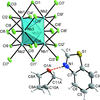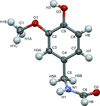issue contents
December 2018 issue

Cover illustration: Eugenol is a natural molecule that exhibits versatile properties useful in various domains. There is increasing interest from the scientific and industrial community in eugenol-based polymers and this bioactive compound has high potential as a therapeutic agent since it has antiparasitic, antiviral, antibacterial, antifungal, anticancer, antioxidant and anti-inflammatory activities. Vanillylformamide [systematic name: N-(4-hydroxy-3-methoxybenzyl)formamide] and eugenol can be considered to be `isosteres' of each other, since they share comparable molecular shape and volume. See: Baillargeon, Rahem, Amigo, Fortin & Dory [IUCrData (2018). 3, x181590].
metal-organic compounds


 access
access

 access
access

 access
access

 access
accessorganic compounds


 access
accessPolar crystal of vanillylformamide through replacement of the alkene by an isosteric formamide group


 access
access

 access
access

 access
access

 access
access

 access
access

 access
access

 access
access

 journal menu
journal menu























![[publCIF]](/logos/authorchecklist11.gif)





